Menus
- Portrait and rotating landscape mode, winding and uneven roads, speed camera warning, roadbook sharing
- The ultimate evolution of the special biker navigator in a "lifetime" version from 349 euros
- 3rd generation of TomTom rider
- Discovery
- Screen
- Ergonomics
- Winding roads and rough roads
- Warning radar
- Recording and sharing
- Voice instructions
- Autonomy
- Updates
- Versions and prices
- Conclusion
- Map of Europe pre-installed: 23 countries
- Map of Europe: 45 countries (including the 23 countries listed above)
Portrait and rotating landscape mode, winding and uneven roads, speed camera warning, roadbook sharing
The ultimate evolution of the special biker navigator in a "lifetime" version from 349 euros
If the evolutions of car GPS are notable every year, motorcycle GPS evolves relatively little and especially with few players. We could even summarize in two the leading motorcycle GPS between Garmin and TomTom with its famous Rider. And what Rider !
Tom Tom’s rider has always been like no other. As much as car GPS devices are very similar, the Rider with its large hull and integrated sun visor has always been the biggest, heaviest and most bulky in its class. Difficult to put it in a pocket. And yet, advantage of its defect, it was particularly resistant not only to water by being completely waterproof, but also to falls. Because an unfortunate maneuver and a GPS fall from the top of the handlebars on the asphalt when in a car it falls at worst on the seat or the carpet. A motorcycle GPS must be more resistant.
TomTom had improved its model with a 2nd generation offering above all a larger screen but keeping an identical exterior aesthetic with the detriment of losing autonomy. The browser had also switched to lifetime maps, after the competition.
Difficult to set off for a day with a motorcycle GPS, without having to connect it to the battery or at least a backup external battery of the type used for mobile phones.
If the interface had evolved noticeably, it remained very close from one generation to the next and retained a resistive screen reacting at best to the support but without having the interaction of the type of capacitive tiles offered by smartphones, especially with two-finger zooms and especially precise pointing. But that was before.
We had tested the prototype of the TomTom Rider. Here is now the preview test on the road of the new GPS which should arrive in the bins in April.
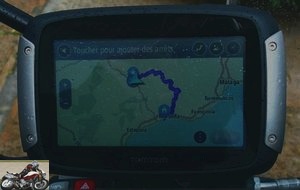
3rd generation of TomTom rider
With its new GPS, TomTom has overhauled everything to offer an entirely new product, at all levels in the same way that a new player could have launched a new browser: new design, new interface, new processor, more internal memory , new operating system … In short, the engineers left with a blank page. The only thing retained is based on the spirit and the functionalities of the product: to offer a solid and waterproof product, intended for motorcycles with special biker functions, but without forgetting neither the design nor the possibilities offered by the latest technologies. And we also find an almost identical appearance of the maps with the usual 2D and 3D modes.
The in-house operating system has been replaced by an Android base (the operating system in particular for many smartphones) and Open Source libraries. Above all, the brand’s car and motorcycle GPS units now benefit from a common base. This means that any improvement in functionality on one of the brand’s models has a high probability of being found on other models and in particular motorcycle..
Discovery
In the end, we discover a magnificent case, standard size compared to an auto GPS, but now design with a mixture of soft touch and brushed aluminum on the sides. Instead of the old screen, there is a modern panel of the smartphone type. However, the rubber exceeds slightly in thickness and suddenly, in the event of a fall, the screen cannot touch the ground but is protected by the rubber shock absorber … On a flat surface. In real life, if the browser falls to the ground and finds a stone in its path, the screen should be a little more sensitive. But the brand’s engineer assures us that the GPS and its screen are particularly resistant. They thus carried out crash tests several times by renewing 100 drops of the same GPS in all positions, at the height of one meter. All GPS models have always worked after.
There is then a slot for an SD card, allowing you to load maps but also roadbooks as well as a miniusb socket to connect the GPS to a computer. TomTom has also developed a partnership with Tyrepro to import roadbooks in .gpx format. You can also download the Repaire motorcycle roadbooks.
All it takes is a slight prolonged press at the top right of the box to turn on the GPS, which lights up considerably faster than the old one and above all, the ignition button of which is more pleasant and easier. It is now possible to choose a standby or total shutdown mode when pressing the same button.
But above all, its size has nothing to do with it. Barely heavier than a car GPS and lighter and smaller than its competitor, it now fits in a jacket pocket. And even if TomTom offers a version allowing it to be padlocked on the motorcycle, we no longer need to walk with it in hand, when the motorcycle is parked..
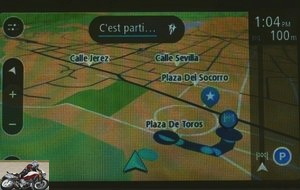
The GPS is now mounted on a ball joint, which allows it to be switched between portrait and landscape mode … and the screen adapts automatically, like on a smartphone. Suddenly, for those who will have fun putting the knee on the ground, the screen tends to rotate automatically when setting the angle of the motorcycle.
Screen
Larger than the first generation with its 4.3 "(11 cm) and equivalent in size to the second generation (Rider V4), the screen is very readable, even under the sun, whereas one might have feared that the panel of ‘glass’ was more sensitive to bad reflections than the older, duller one.
You can now point your finger at each area of the screen, with the same ease and precision as a smartphone. It is thus possible to add waypoints by pressing on an area of the screen to build a roadbook directly on the screen and without necessarily going through menus with intermediate destinations. What was tedious with the old model now becomes easy and fast.
You can also zoom in and out with two fingers in a precise way, without having to resort to the traditional "plus" and "minus" screen buttons of older generations. In short, we finally find the ease of use of the latest GPS cars and smartphones.
And with the gloves? well, it also works, even with the gloves still winter worn for the occasion.
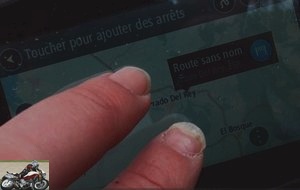
The screen adapts automatically when the case is rotated, which allows it to be positioned horizontally or vertically. In portrait mode, we can see the road ahead.
Ergonomics
What about the menu system? Well, it’s entirely new as well. You move from one screen to another, no longer by clicking on an arrow on the screen (which still exists on each side), but by sliding your finger in the desired direction. It’s more intuitive on a daily basis and easier on the handlebars. But arrows are also available.
The icons clustered in six fronts on each screen. Each screen reduces the number to three now.
From the first screen, we find the essentials with: SEARCH / TAKE A SENSATIONS ROUTE and MY JOURNEYS to use one of the paths in memory (we just regret the thrilling journeys of the first translation of the initial prototype).
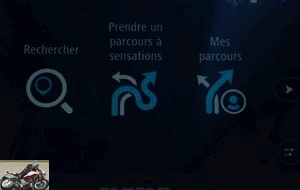
The second screen offers: CURRENT ROUTE / START REGISTRATION / MY DESTINATIONS.
The third screen offers: SERVICE STATION / CONNECTED SERVICES / TRIP STATISTICS. The GPS thus provides average, maximum speed. Duration, etc … Something that cannot be found on an auto GPS.
There is then a screen to access the language, voice type settings options….
To search for a destination or make a route, we now have two keyboards depending on the size of the keys. And even the smallest keyboard can be handled with gloves.
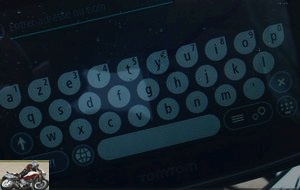
But the innovation is elsewhere because the biker does not need a GPS for the same reason as a motorist.
A motorist needs to go from point A to point B, possibly with a few stops. The biker wants to find the roads that turn the most.
Winding roads and rough roads
And that’s what the new TomTom Rider offers. The winding road function already existed and is no longer unique to TomTom today. TomTom has added intensity levels to the function. You can now choose 3 levels of intensity of sinuous road that we can combine with three levels of height difference.
The GPS is no longer just a navigator but a guide that offers you a more or less winding route with more or less intense elevation to offer you a loop of a certain duration for a certain mileage..
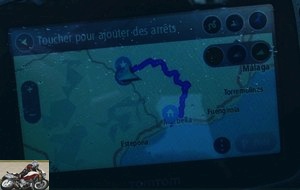
The biker still made intensive use of road maps in the past, precisely to find those famous turning roads. Now, around a starting point, the GPS is able to offer a ride that meets the wishes of the biker.
Warning radar
The bikers did not always carry a GPS but used a radar warning? TomTom’s new model now incorporates this functionality, both for fixed speed cameras but also for mobiles, thanks to the TomTom community! Tried in Spain, the count in meters up to the radar was even very precise. Too bad, in France, we will undoubtedly suffer the restriction with the danger zones and we should lose this precision to ten meters near the model which is however quite capable of it. You can then configure the alarms to signal the zones permanently or only during excessive speed..
The only thing disabled so far on our test model was the ability to report a speed camera to the community while the auto version allows it. And it is moreover on the basis of the reports provided by the cars that the Rider signals the mobile radars. Of course, it is more dangerous for a biker to let go of the handlebars to signal a speed camera than for a motorist to do so while driving..
Recording and sharing
The other functions are more traditional. We thus find the possibility of saving a route, to redo it or export it to share it later with friends. TomTom even announces that this sharing can soon be done from one TomTom to another. It is not yet effective for its release in April but it will be possible during a next software update, knowing that all the technical features are already in place, especially via Bluetooth, etc….
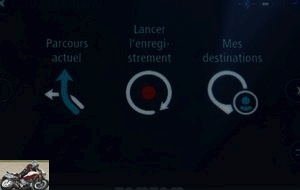
Voice instructions
It is this same Bluetooth that makes it possible to pair a helmet or communication system with the Rider, allowing you to hear the voice instructions. Pairing is extremely simple and does not disconnect at all times as we have experienced on old models. It should be noted that the test was carried out with the Schubert C3 equipped with its communication system. Particularly well integrated, the sound quality is truly exceptional. It also comes at a significant cost, but eliminates the need to look at the screen and allows you to concentrate on the road. The TomTom also offers 5 levels of details for these famous voice instructions, enough to limit their number to only reserve them for changes of direction in particular.
And we then have the choice between the voices of Catherine or Thomas … And other voices on condition of downloading them.
Autonomy
TomTom announces an autonomy of 6 hours, variable depending on the use or not of Bluetooth and especially the level of brightness of the screen. During our test day, unplugged, we were able to verify an autonomy of 5 hours, but with the screen at its maximum brightness. Note that at the end of autonomy, the browser cut the screen but continued to give oral instructions … Enough to significantly extend the guidance.
Updates
The software is updated every two months for those who want to benefit from the latest improvements and features and it only takes 5 minutes to load. The foolish cards. Updates once a quarter and depending on the number of cards, the update can then take up to an hour.
Versions and prices
The rider is now available in three versions with the Rider 40, 400 and 400 Premium Pack models. Good news, we can almost say that the price has not changed, since the TomTomRider Europe was at 399 euros (and we can find it on the internet at 340 euros).
The differences between the first two versions lie mainly in the number of cards available between 23 and 45 for Europe. But there is still traffic integrated for life from the model 40. The model 400 incorporates the community danger zone alarm. The 3rd version incorporates a protective cover as well as the support allow you to also use the GPS in the car. Because indeed, as much as the old model was difficult to integrate into a car, the new one has its place. Above all, the 3 model incorporates a small kit allowing the browser to be locked on the motorcycle, using a padlock / key pair positioned on the support.
The prices then range between 349 euros and 499 euros. It’s significantly more expensive than a car GPS, but with full waterproofing and all services as well as lifetime mapping updates..
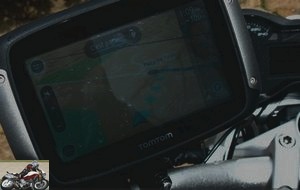
Conclusion
TomTom has just unveiled a revolution in the history of the Rider with this model which completely breaks with existing models for 10 years. And as much, the previous evolutions did not encourage me seen the blow of the box to change, this new model completely justifies to take the step and to invest; and even more when one considers now a mixed use car and motorcycle, integrating traffic and updates for life. The Rider has become not only a useful product, but also more beautiful, practical, easy and light which can now be put in a pocket. In short, it now incorporates everything you would expect from a motorcycle GPS. At most, we dream in a future version of seeing the tourist points of interest on a route appear. Nobody does it on a motorcycle yet, but it has existed in the car. In the meantime, this is the case of Le Repaire’s roadbooks which integrate cultural and tourist places placed on the road, so no need to wait for a 4th generation..
On the availability side, we still had pre-series models, but the boxes are planned in stores and on the internet from April.
Strong points
- look, weight and size
- winding areas
- lifetime cards
- integrated traffic from the basic model
- portrait and landscape modes
- radar warning
- touch screen and precise
Weak points
- the price of the Premium Pack
Map of Europe pre-installed: 23 countries
Germany, Andorra, Austria, Belgium, Vatican City, Denmark, Spain, Finland, France, Gibraltar, Great Britain, Canary Islands, Ireland, Italy, Liechtenstein, Luxembourg, Norway, Monaco, Malta, Netherlands, Portugal, Sweden, Saint-Martin, Switzerland.
Map of Europe: 45 countries (including the 23 countries listed above)
Bulgaria, Croatia, Estonia, Russian Federation, Greece, Hungary, Ireland, Italy, Latvia, Lithuania, Poland, Czech Republic, United Kingdom, Serbia, Slovakia, Slovenia, Turkey, plus major roads in the following countries: Albania, Belarus, Bosnia and Herzegovina, Macedonia, Moldova, Montenegro, Romania and Ukraine.
Available at Tecnoglobe
Related articles
-
Tomtom Rider V2 motorcycle GPS test
Motorcycle GPS, 2nd edition The TomTom Rider – now in its version II – is the GPS specially designed for motorcycles by TomTom. Available in France and…
-
Rider 5000 electric scooter test
Daily test for one month of the 125 equivalent with a retro look 95 km / h, range 100 km, power 5 kW, battery 3.6 kWh In electric, there are machines…
-
The Touring sporty version … or the other way around… After the RT and especially the Spyder F3-S, Can-Am returns with a new three-wheel model placed…
-
Urban GT scooter Hexagon, X8, X9…. Piaggio has come a long way since 1993, posting more than 400.00 cumulative sales for the brand, which is the segment…
-
Harley-Davidson Low Rider S Test
A cruiser in the S Series and Dark Custom range Screamin ‘Eagle Twin Cam 110 V-Twin of 1,801 cm3 delivering 156 Nm And 7! The Dark Custom family…
-
Honda Hornet 600 – CB600F 2007 vintage motorcycle test
Ten-day test of the 2007 vintage Exit on the heels of the wicked roadsters ago more than 9 years, the CB600F Hornet has been completely revised in 2007….
-
Zero SR / F electric motorcycle test
Showtime ! Electric motor with 110 hp and 190 Nm, 220 kg, 200 km / h, from 20,690 euros Today, there are two main families of motorized two-wheelers…
-
Grand Tourism Test over 2 weeks and 1,500 km, including 600 km in one day What a long way BMW has come since the arrival of its S1000RR, the brand’s…
-
The fully equipped Dolce Vita Big wheels, lines and Italian style, the SH has been one of Honda’s flagship scooter lines since 2001, with over a million…
-
Test scooter BMW C600Sport vs C650GT
Between Zyva and Bobo One would have thought that after the success of the C1, the brand’s first foray into the scooter segment, BMW would have buried…
Thank you for your review, I ordered this xsr abarth, I hesitated between it and the bmw nine t racer but my choice is made now I am waiting for it to arrive 😉
Thank you for your comment! Do not hesitate to tell us your first impressions when you take possession of them. You know the XSR in standard version ?
Philippe
AND if we replace the handlebars with the original one? we keep the look and the advantages, by regaining the dynamism of the standard
superb motorbike
will let me try
case to follow
I find this model ugly … shame to see the XJR go for this thing…
After it is necessary for all tastes.
No kidding, when I see what Rolland Sand lays down and the final result, I wonder what the Japanese engineers can have against this bike which did not ask anyone for anything. The RS design version must even cost less to produce (no aluminum headlight, etc.). Out of the mill and the superb meter which for once would go very well to the basic MT09, to the trash, the turd. : {
Personally, apart from the headlights, I like it in "Roberts" colors
They could do it in Sarron’s colors, and also in red / white, that would suit him well
If the Bridgestone S20, due to their round profile, are suitable for the progressive reactions of the machine, would the S21 or S22 (with more pointed profiles) be suddenly not recommended?
Uh, say see, did you take the photos out of the box? She’s not fully assembled there? Yes ! I would never understand Yamaha … A rather nice engine, put in all the sauces, but it’s not the big kitchen … Rear brake reservoir visible, hoses and cables ditto, engine bolts, no integration effort to give a pleasant appearance.
he looks good to new tom.

but I don’t think he would make me give up my tripy
I find this motorcycle very poorly proportioned. So ugly!
Thanks to Yamaha for painting this radiator black. !
V.